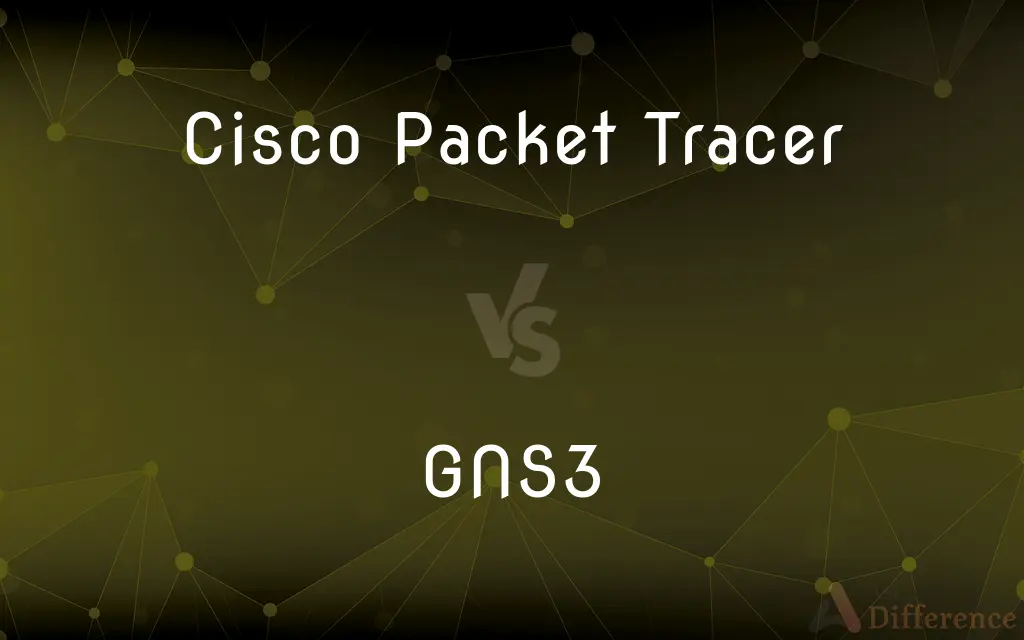Cisco Packet Tracer vs. GNS3 — What's the Difference?
By Tayyaba Rehman — Published on January 25, 2024
Cisco Packet Tracer is a network simulation software focused on educational purposes, while GNS3 is an advanced network emulator used for professional network modeling and testing.

Difference Between Cisco Packet Tracer and GNS3
Table of Contents
ADVERTISEMENT
Key Differences
Cisco Packet Tracer is a network simulation tool developed by Cisco Systems, primarily used for educational purposes to help students learn networking concepts and Cisco's networking protocols. It offers a user-friendly interface and a variety of virtual equipment for creating simulated network environments. GNS3 (Graphical Network Simulator-3) is an open-source network emulator that allows users to emulate, configure, test, and troubleshoot virtual and real network environments. It is more complex and offers a more realistic networking experience.
Cisco Packet Tracer provides a controlled environment with a limited set of Cisco-specific devices and features, making it ideal for beginners in networking. It is less resource-intensive and easier to set up. In contrast, GNS3 supports a wider range of real network hardware and software images, allowing for more advanced and realistic network simulation. It requires more technical knowledge to configure and use effectively.
The primary use of Cisco Packet Tracer is educational, allowing students to create network topologies and simulate basic network operations without real hardware. GNS3 is used by network professionals for testing network architectures, preparing for certification exams, and prototyping network solutions before actual deployment.
In terms of performance, Cisco Packet Tracer operates mainly at the IOS command line interface level, with limited support for live data traffic. GNS3, however, allows the emulation of live data traffic, supporting more dynamic and complex network interactions. It can integrate with real network equipment and VMs for comprehensive testing.
Cisco Packet Tracer is generally considered easier for beginners due to its simplicity and educational focus. GNS3, with its ability to emulate real network scenarios, is preferred by network engineers and professionals for in-depth network design and troubleshooting.
ADVERTISEMENT
Comparison Chart
Purpose
Educational network simulation
Advanced network emulation
User Interface
User-friendly, ideal for beginners
Complex, suited for professionals
Hardware Support
Limited to virtual Cisco devices
Supports a wide range of real network hardware
Use Case
Learning networking concepts
Professional network modeling and testing
Traffic Simulation
Limited live data traffic simulation
Supports emulation of live data traffic
Compare with Definitions
Cisco Packet Tracer
A network simulation tool for learning purposes.
I used Cisco Packet Tracer to practice my CCNA lab exercises.
GNS3
Used by professionals for in-depth network design and troubleshooting.
Before deploying the network, we prototyped it in GNS3.
Cisco Packet Tracer
Features a user-friendly interface for beginners.
The drag-and-drop functionality in Cisco Packet Tracer makes building networks easy.
GNS3
Suitable for advanced users due to its complexity and realistic simulation.
GNS3 helped me prepare for my network certification by simulating real-world scenarios.
Cisco Packet Tracer
Less resource-intensive and easy to set up.
Setting up a virtual network in Cisco Packet Tracer took only a few minutes.
GNS3
An advanced network emulator for professional network testing.
I used GNS3 to emulate a complex network environment for my project.
Cisco Packet Tracer
Simulates a controlled environment with virtual Cisco devices.
We can experiment with different network topologies in Cisco Packet Tracer.
GNS3
Supports real network hardware and software images.
GNS3 allows me to test configurations on the exact IOS version used in my company.
Cisco Packet Tracer
Ideal for students learning Cisco networking protocols.
Cisco Packet Tracer helped me understand how OSPF protocol works.
GNS3
Integrates with real network equipment and VMs for comprehensive testing.
I integrated my physical router with GNS3 for a hybrid network setup.
Common Curiosities
What is GNS3?
GNS3 is an open-source network emulator for professional network modeling and testing.
Who should use Cisco Packet Tracer?
It's ideal for students and beginners in networking.
Is Cisco Packet Tracer free to use?
Yes, it's free for individuals with a Cisco Networking Academy account.
What is Cisco Packet Tracer?
It's a network simulation tool developed by Cisco for educational purposes.
Does Cisco Packet Tracer require a lot of computing resources?
No, it's relatively light on resources.
Does Cisco Packet Tracer support advanced network topologies?
It supports basic to intermediate topologies.
Is GNS3 suitable for beginners?
GNS3 is more complex, better suited for network professionals.
Can I use GNS3 for real network traffic simulation?
Yes, GNS3 supports the emulation of live data traffic.
Can I use real IOS images in Cisco Packet Tracer?
No, Cisco Packet Tracer uses pre-configured, simulated devices.
Can GNS3 be used for CCNA/CCNP training?
Yes, GNS3 is excellent for higher-level Cisco certifications training.
Can GNS3 be used to practice for non-Cisco certifications?
Yes, due to its support for a wide range of network hardware.
Does GNS3 support real network equipment?
Yes, GNS3 can emulate real network equipment and integrate with actual hardware.
Is Cisco Packet Tracer sufficient for CCNA exam preparation?
Yes, it covers most scenarios needed for CCNA.
Can I integrate VMs in Cisco Packet Tracer?
No, Cisco Packet Tracer does not support external VM integration, unlike GNS3.
How realistic is the network simulation in GNS3?
GNS3 offers a highly realistic simulation environment.
Share Your Discovery

Previous Comparison
BLS vs. ACLS
Next Comparison
Mosquito Forceps vs. Artery ForcepsAuthor Spotlight
Written by
Tayyaba RehmanTayyaba Rehman is a distinguished writer, currently serving as a primary contributor to askdifference.com. As a researcher in semantics and etymology, Tayyaba's passion for the complexity of languages and their distinctions has found a perfect home on the platform. Tayyaba delves into the intricacies of language, distinguishing between commonly confused words and phrases, thereby providing clarity for readers worldwide.












































